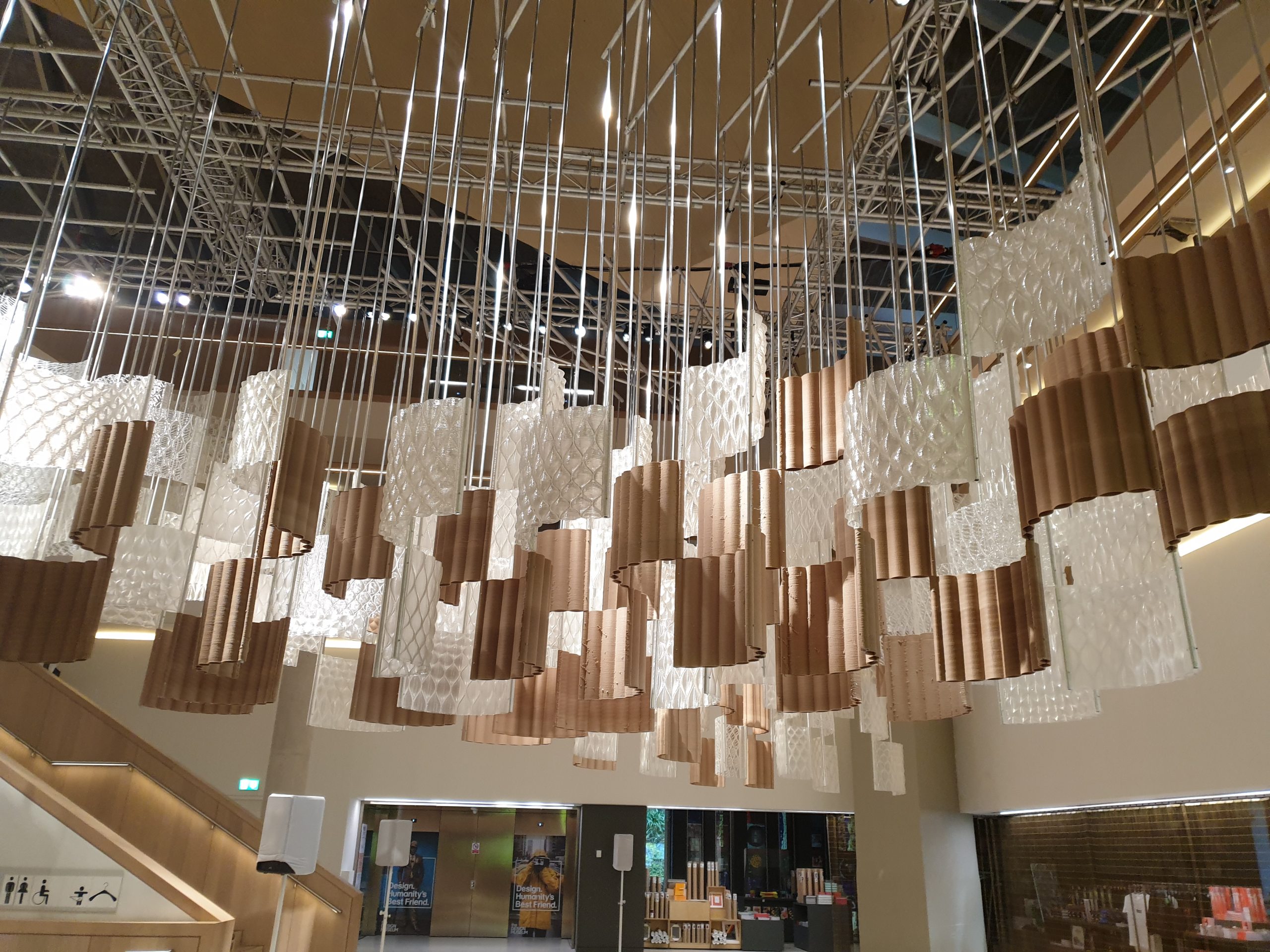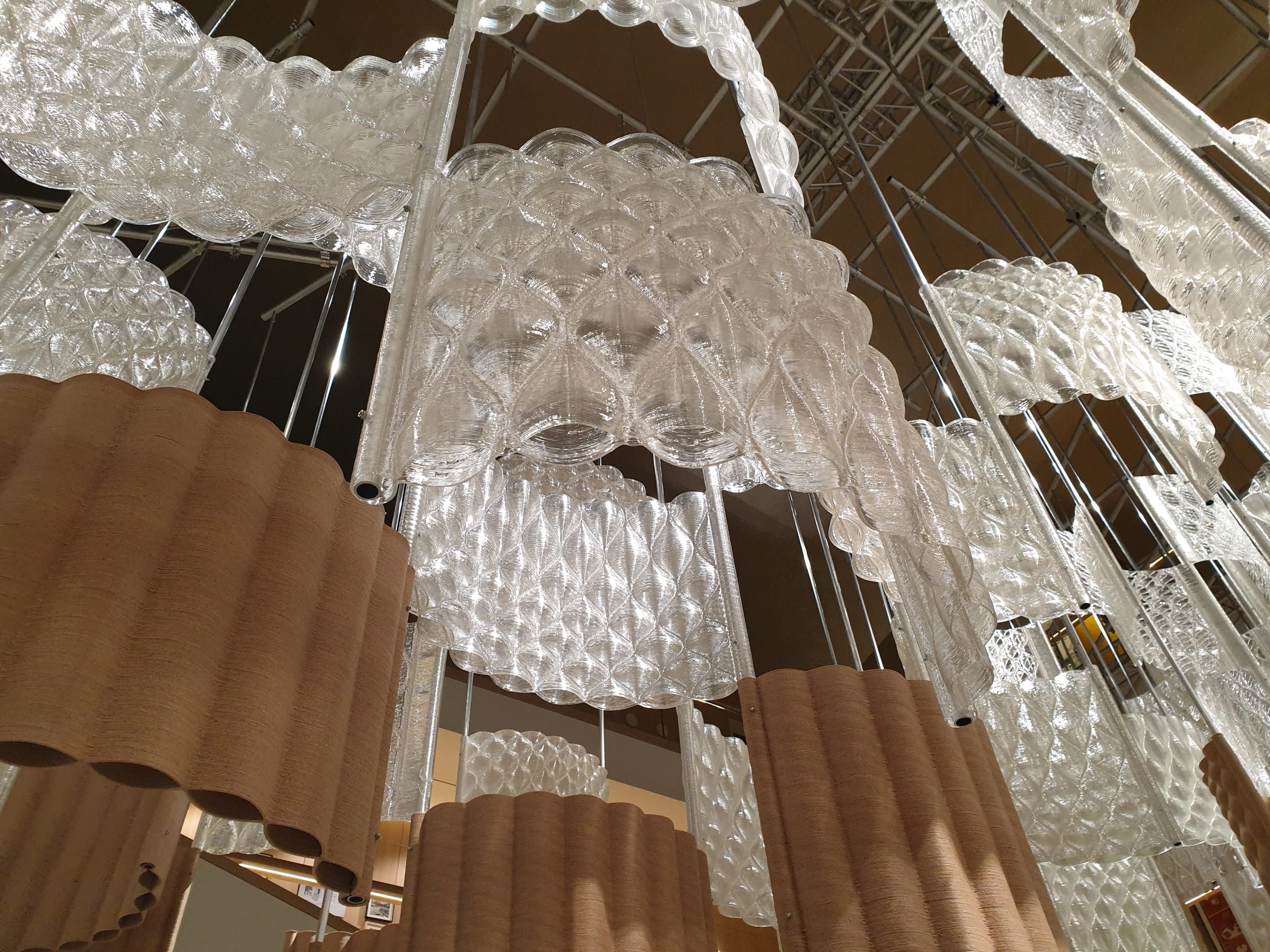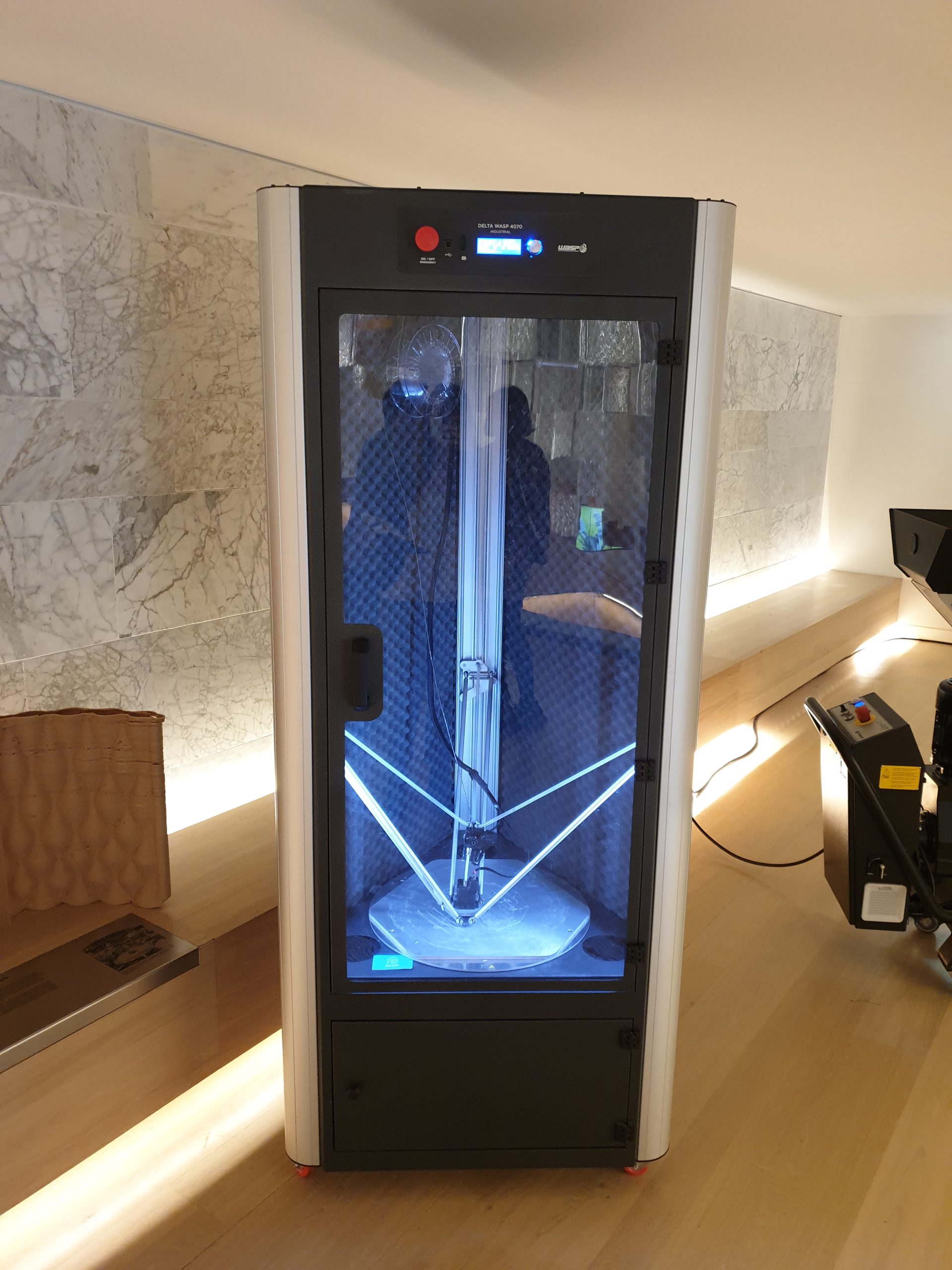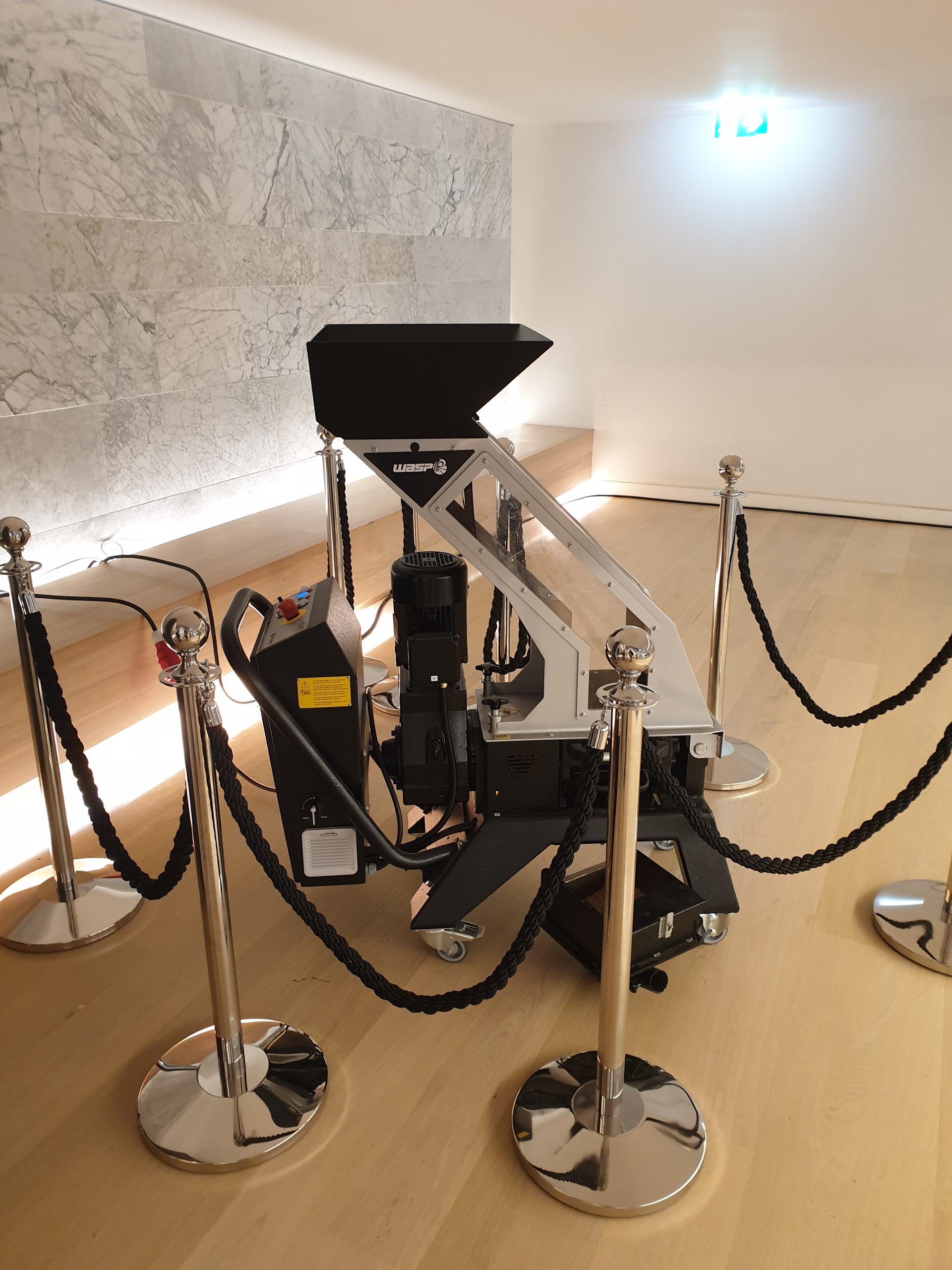A new installation that fuses art, science and industry to showcase the possibilities of sustainable design has opened to the public at the Design Museum in London.
Since Saturday, visitors have been greeted by cascades of curved and imperfect 3D printed bioplastic and wood panels suspended above the museum’s entrance hall as part of its new ‘Waste Age’ exhibition, which explores the role design can play in reducing waste generation, increasing circularity, and improving global sustainability.
Named AURORA, the installation aims to inspire a “new aesthetic for a more renewable world”, and was designed and produced by 3D CAD software provider Dassault Systèmes and London-based architect Arthur Mamou-Mani.
During an exclusive preview of the exhibit before its opening to the public, I sat down with Mamou-Mani and Dassault Systèmes’ VP Design Experience Anne Asensio, to delve deeper into AURORA’s design and construction and gain insight into the role 3D printing and design can play in moving us away from our current “take, make and waste” approach to living.

Reaching ‘peak waste’
The Design Museum’s new Waste Age exhibition aims to expose the current “take, make and waste” economy present in many regions of the world that has contributed to the ongoing environmental crisis. The exhibition seeks to explore what design can do to rethink the way we produce and consume goods by showcasing how artists and designers are transforming waste into valuable resources and developing new materials and systems to guide us towards a cleaner, greener future.
According to the exhibit, the world currently produces two billion tons of rubbish each year, and only 15 percent of this waste is recycled. The remaining waste contributes to climate change through the production of greenhouse gases, such as carbon dioxide and methane, which are causing the Earth’s temperature to rise and subsequently leading to more extreme weather patterns across the globe.
Through the Waste Age exhibition, designers like Mamou-Mani are showing how, by replacing our “take, make and waste” model of living with a circular approach to design, manufacturing and consumption, we can keep vital minerals, metals, and other materials circulating in our supply chains, rather than burning or burying them.
“It’s part of a journey, which has several installations speaking about the topic of the circular economy,” he said. “3D printing is not just about technology. It’s actually about empowering communities to make for themselves, as opposed to expecting to buy finished things.
“How do you ultimately empower communities? By giving them the tools to make things happen, the possibility to create something, the very first spark of creativity and knowing that creativity will lead somewhere.”

The concept behind AURORA
Although AURORA is just one element of the Waste Age exhibition, the impressive installation is the first thing visitors see as they walk through the museum doors. Throughout the project, Mamou-Mani and his team sought to show how leveraging Life Cycle Assessments (LCAs) and implementing informed design processes could help to reduce the environmental footprint of manufacturing.
The installation was designed and produced in London at Mamou-Mani’s fabrication hub FabPub, which is a member of the Dassault Systèmes 3DEXPERIENCE Marketplace. Operating on the 3DEXPERIENCE platform, the cloud-based marketplace connects designers, engineers, makers and production planners with 3D printing service providers.
AURORA was not approached as merely an object, but as an optimized “design for life” that can be broken down and recycled into new structures and therefore given additional lives. Through the structure, Mamou-Mani seeks to address the very question of sustainability itself.
“Something is only waste when we see it as that,” he offered. “When in fact, waste is just part of a cycle. So to me, the word waste suggests that we accept that something has an end. And actually, that is very linear.”

Designing AURORA with sustainability in mind
In their quest for alternatives to fossil-based plastics, Mamou-Mani and Dassault Systèmes set about choosing the materials to create the AURORA installation by carrying out a LCA of PLA, a non-toxic and recyclable thermoplastic, versus another common thermoplastic, ABS. The team continued to use LCA tools to evaluate the sustainability impacts of every choice they made throughout the design and development process.
The LCA showed that PLA demonstrated similar mechanical strength and plasticity to ABS, but required less energy to produce due to its lower melting temperature. In addition to its favorable eco-credentials, PLA was chosen for the project as it can be crushed and 3D printed repeatedly, making it an ideal material for circular experimentation. The team embraced the inevitable printing irregularities resulting from the crushing and 3D printing process, and celebrated their “unique aesthetics” as part of AURORA’s design.
“We have a crusher in the studio, and we can put those pellets back into the waste stream and try to stay waste-free by reusing anything we do not end up using,” Mamou-Mani said. “A lot of the materials we source from sustainable farms, but this requires land. And when we did the LCA that’s the one thing that is not as good as petroleum-based plastics – land use. And that’s an interesting point, because if that is the only thing then our energy could be focused on vertical farms and things like that.
“I’m looking forward to tackling this issue and working on vertical farms as well as making our own plastic. I think that will close the loop, so to speak.”

On the design process side of things, the team’s online communities of innovators helped to build a comprehensive body of architectural principles and concepts on shared dashboards, in order to provide the basis for AURORA’s design. The team then leveraged Dassault Systèmes’ xGenerative Design software to craft the individual modules before designing the entire architectural system. Using the software, Mamou-Mani and his team were able to formalize their architectural concepts and fine-tune the structure’s assembly, disassembly, and modularity.
Once Mamou-Mani was happy with AURORA’s design, the modules were assembled in a virtual 3D model of the Design Museum using Dassault Systèmes’ 3DEXPERIENCE platform. Through the platform, the team could visualize the installation as if it had already been built and could conduct precise scientific simulations and further LCAs on the structure. The most important aspect of the platform, though, is that it provided a space for the design team to run with their ideas, according to Asensio.
“When you want to make a great project it is not about the tools, or the technology, and definitely not about the process either,” she said. “It’s about a state of mind and the capacity to create links. 3D printing and design is at the heart of community, and that’s why work on the 3DEXPERIENCE platform for us has never stopped. It’s a cradle.”
She added: “The platform basically enables you to actually situate the project within an environment of collaboration, and this is really becoming a hub for accessing all of that expertise and demand. It is not like an industrial process, it operates more like a studio and the platform is made by community.”
The platform’s Live Rendering & Ambiance tools also enabled the team to produce photo-realistic visuals at each stage of the process in order to make decisions on materials and colors, and refine the structure’s lighting and textures early on in the design process. The team also made use of Dassault Systèmes’ PowerFLOW software to simulate the airflow around AURORA in order to ensure a safe and enjoyable experience for visitors.
“The notion of virtual twins means that we are basically catalysts of endless hypotheses that already exist for our customers,” Asensio said. “The platform foremost caters for people in the future who want to resolve issues by stepping outside of monolithic processes.”
Mamou-Mani added: “It was a way to play and test different arrangements and constantly iterating and adapting to not just the space, but also the materials, we used the constraint of the sizes to engineering, the lights – there are so many aspects in a project that needs a sort of centralized representation of all these different elements, so that was extremely helpful.”
In fact, the ability to fully visualize the structure before it had been built turned out to be far more useful to Mamou-Mani than he had first visualized.
“I don’t think we could have done it without the visual twin,” he explained, “because the project was supposed to be in Milan before Covid-19 and then got canceled, so we moved here, found this exhibition, and thought it would be perfect.”
The sudden change in venue meant that Mamou-Mani had to reimagine everything, from how the structure was going to hang in the new venue, as initially there was nothing to suspend from, to adapting to the space being smaller than the original venue.

3D printing AURORA
Once the design phase was complete, Mamou-Mani and his team began 3D printing the individual modules for AURORA using a Delta WASP 3D printer. When asked why he chose that particular machine for the project, Mamou-Mani spoke of the company’s vision for its Shamballa 3D printed eco-friendly housing project.
“It’s such a joyful collective of people, same as their system,” he said. “When people do their work out of passion and out of belief, I don’t see a job as a job, and this is where we have a purpose and they have a purpose.”
Now that AURORA has been 3D printed and displayed in the Design Museum, Dassault Systèmes’ community of makers and designers are working on ways to repurpose the structure’s modules and enable them to continue delivering value. Modules that cannot be reused, repurposed or recycled will be turned into biomass.
“Our shared hope is that this piece has a third life, let’s say, which would maybe be as a structure in general,” said Mamou-Mani. “I think at first we’re going to put it aside and then have a good think about how that would work. You always think about the next iteration, how you want it to look, and there is something so exciting about the ability of re-doing, reusing and rethinking.”
According to Mamou-Mani and Asensio, AURORA can be considered not only as a demonstration of sustainable design but as a potentially functional structure in the future.
“It’s the beginning of being able to use 3D printing for facades, for partitions, for furniture, and so on,” offered Mamou-Mani. “The possibilities are really endless. It really started to show combinations that could lead to architectural scale. It’s not there yet, because the materials need a lot of thinking in terms of diversity, UV resistance, and fire resistance, but it’s a start, and we are already exploring this.”
“It’s really about the way we interact,” agreed Asensio. “We have a need for housing and building, in the past we had at our disposal earth, bricks, but housing has been taken as an industrial process. That’s what needs to stop. We have with this approach the ability to actually not just provide the only avenue for people to live within, but perhaps a more organic way where every creator and every house is adjusted to your living.”

The future of 3D printing for sustainable design
Designers like Mamou-Mani are seeking to change the way we think about waste. Each year, we use more resources than our planet can regenerate, with 1.75 planet Earths needed to support our current demands.
“What 3D printing offers is an alternative to disrupt the current linear industrial process,” said Asensio. “At the beginning, the industry was producing goods that we didn’t have but what we needed, and the waste was not there because we were using good and virtuous materials. But, the industry got crazy and lost sight of the duty of just providing goods, to moving to make money.”
According to Asensio, it was the switch from producing for necessity to producing even if the demand was not there, which has eventually led to the huge levels of waste we see today.
“The linear economy is all about mass market, mass material, mass extraction,” she continued. “And, I think that 3D printing is going back to where design should act in our daily lives.”
“Mass production leads to waste,” added Mamou-Mani. “There is so much diversity in people and cultures, and yet we mass produce. And that doesn’t equate, it doesn’t balance up with the idea of diversity. With 3D printing you can customize on-demand.”
Alluding to the United Nation’s upcoming COP26 Climate Change Summit, Asensio stressed the importance of including artists, designers and other creatives in policy discussions.
“When you have power, there are many ways of using it,” she offered. “It can be used to just accelerate the current attitude and giving more power to the industry, or you can place yourself with a design-thinking attitude, where you put the human at the center and the empowerment of people. The only way you do that is by collaborating with artists, with architects, with people who really have a head for what enables people.”
However, Asensio believes politicians and policymakers “don’t trust artists and creative people,” and are still trying to approach the climate crisis with a one-size-fits-all approach. “If we just had a different way, a different framework, where we are not imposing but letting people actually imagine ways of addressing these problems, you empower them.
“That is really important to COP26, to encourage companies to give tools to the artists, designers and people who may have a better view of things.”
Naturally, Mamou-Mani agrees with Asensio, believing that, “having people from the art world or from the more industrial world partnering and breaking the boundaries between what is seen as art or what is seen as industry, or software, or machines, is really helpful.” According to him, the combination of creatives and industry players has the “power to change things” and would enable a much bigger impact than politics alone.
Asensio views 3D printing as the “incarnation of the future” with the potential to enable creatives in society to come up with new solutions to tackle the climate emergency. “The industry is kind of a blind spot for most policymakers,” she added. “They think that the industry will just need to be controlled and add some strong indicators, and that they are not part of the solution. This is a huge mistake. 3D printing is really tackling this on the small scale, the human scale, and all the way to the climate scale.”
AURORA and the entire Waste Age exhibit is now open to the public, hosted at the Design Museum in London.

Subscribe to the 3D Printing Industry newsletter for the latest news in additive manufacturing. You can also stay connected by following us on Twitter and liking us on Facebook.
Looking for a career in additive manufacturing? Visit 3D Printing Jobs for a selection of roles in the industry.
Subscribe to our YouTube channel for the latest 3D printing video shorts, reviews and webinar replays.
Featured image shows the AURORA installation designed and produced by Dassault Systèmes and Arthur Mamou-Mani. Photo via Hayley Everett.



